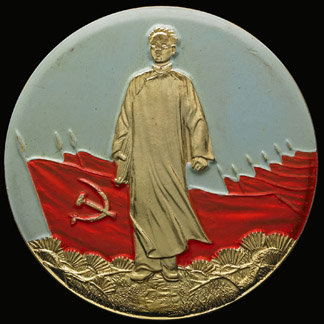Icons of Revolution
dal 9/4/2008 al 13/9/2008
Segnalato da
9/4/2008
Icons of Revolution
British Museum, London
Mao Badges then and now

Room 69a
Admission free
Five billion badges were made during China’s Cultural Revolution (1966–76). They became part of everyday dress code and were worn as an expression of loyalty to Chairman Mao and the Communist Party of China. Almost every Chinese person wore one, from Premier Zhou Enlai down to the smallest child. These badges, with their striking designs and revolutionary inscriptions, were usually presented as gifts, often to commemorate special occasions.
The British Museum has a collection of around 350 Mao badges, all of which have been donated since the 1970s. Examples from this collection, together with banknotes, coins, posters and other objects, will form the basis of this small display which will examine the iconography on Mao badges, where it came from and how some of it is used today.
Mao’s portrait appears on most of the badges. Scenes from his life, important political events, his poetry and his ‘thoughts’ are also featured. The badges combined symbols of international Communism, such as the hammer and sickle, with traditional Chinese designs, such as plum blossom, a symbol of long life and survival in adversity. Sunflowers were often depicted as a symbol of loyalty to Mao, who was ‘the red sun in the hearts of the people’.
Many badges refer to the establishment of the People’s Republic of China, on 1 October 1949, an occasion celebrated annually as National Day. Others feature symbolic images found in the ‘national emblem’, announced in 1950. The emblem shows the five stars of the national flag above Tian’anmen, a cogwheel and ears of grain. The five stars represent the different peoples of the PRC, the cogwheel workers and industry and the ears of grain farmers and agriculture. Tian’anmen was where Mao announced the establishment of the People’s Republic of China. Important historical landmarks, known as ‘revolutionary sacred sites’, also appear on badges. These include Shaoshan where Mao spent his childhood and Yan’an, the final stop on the Long March (1934-1935), which became the Communist centre.
Although Mao’s portrait and slogans appeared almost everywhere during the Cultural Revolution, his image did not appear on money of the People’s Republic of China until the 1980s. Designs on coins and notes (renminbi – ‘people’s money’) were intended to highlight the achievements of socialist construction and the new face of China. Examples show the newly constructed bridge over the Yangtse, young people from urban areas going to work on the land and a female tractor driver. The striking design and powerful language of the imagery and inscriptions of the Cultural Revolution permeated every aspect of life in China in the 1960s and ‘70s. In those days, any disrespect (however accidental) towards these highly charged icons might lead to the most serious consequences. Forty years on, the use of these icons has changed. Whereas Mao’s image was once absent on the banknotes of the 1960s and ‘70s, today his image appears on all denominations of notes issued by the People’s Bank of China.
Much of the visual imagery of the Cultural Revolution has been defused of its original earnestness, and has been appropriated, adopted and adapted to suit new purposes. It now features in contemporary Chinese art and design, as well as in international advertising, often with an ironic twist.
British Museum
Great Russell Street - London



